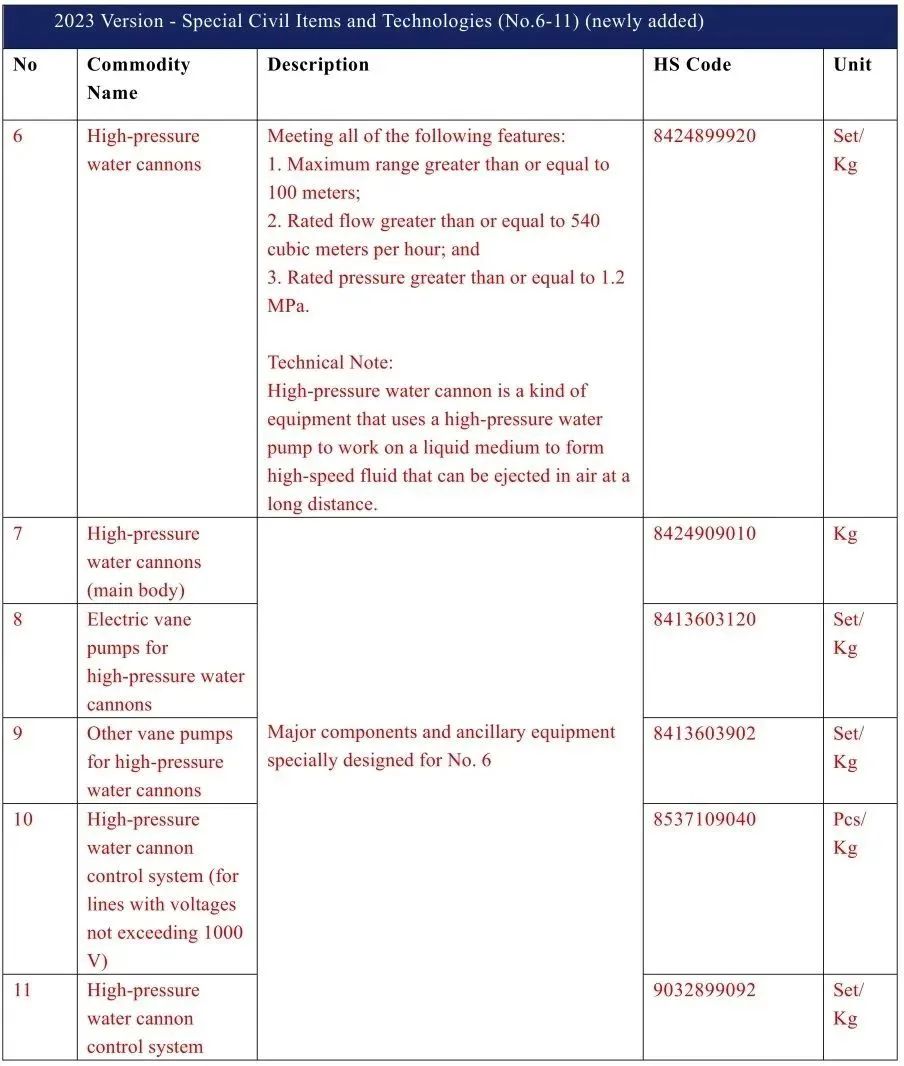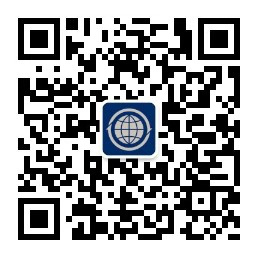“Exporting business operators (‘EBOs’) are expected to establish in advance an internal control program (‘ICP’) for export control compliance purposes which paves the way for obtaining a general license or license exemptions. The Ministry of Commerce (‘MOFCOM’) may conduct compliance evaluations for EBOs without ICPs, which may trigger law enforcement investigations and penalties.”
“When conducting compliance checks, EBOs shall not only check the scope of commodities according to the Export Control Catalogue, but also make sure the HS codes have been correctly and lawfully classified under the Tariff Schedule of the PRC for Imports and Exports to achieve both ‘export control compliance’ and ‘customs classification compliance.’”
On December 30, 2022, the Ministry of Commerce (“MOFCOM”) and the General Administration of Customs of China jointly released the 2023 Catalogue of Dual-use Items and Technologies Subject to Import and Export License Administration (“Dual-use Catalogue”) under the Announcement No. 42 of 2022. This updated Dual-use Catalogue took effect on January 1, 2023, and the 2022 Dual-use Catalogue issued under the Announcement No. 48 of 2021 was abolished simultaneously.
This alert does not address the import control component of the Dual-use Catalogue. We only introduce the export control component, namely the Catalogue of Dual-use Items and Technologies Subject to Export License Administration (“Export Control Catalogue”).
I. Layout of Sub-catalogues
Since the implementation of the Export Control Law of the PRC at the end of 2020, there are no substantial changes in the structure of the Export Control Catalogue. Again the 2023 Export Control Catalogue consolidates eleven sub-catalogues, namely: 1. Items and Technologies in the Nuclear Export Control List; 2. Items and Technologies in the Export Control List of Nuclear Dual-use Items and Related Technologies; 3. Items and Technologies in the Export Control List of Biological Dual-use Items and Related Equipment and Technologies; 4. Items in the List of Controlled Chemicals; 5. Items and Technologies in the Export Control List of Certain Chemicals and Related Equipment and Technologies; 6. Items and Technologies in the Export Control List of Missiles and Related Items and Technologies; 7. Precursor Chemicals (I); 8. Precursor Chemicals (II); 9. Certain Dual-use Items and Technologies; 10. Special Civil Items and Technologies; and 11. Commercial Cryptography Export Control List. Sub-catalogues 1-8 are based on international multilateral export control regimes, while Sub- catalogues 9-11 are China’s unilateral export controls in nature.
The exporting business operators (“EBOs”) need to determine whether an item to be exported falls into the Export Control Catalogue according to the names and descriptions of the commodities in the catalogue, while the corresponding HS codes of the commodities are provided for reference only. Please note that in this article HS code means the China tariff code with ten digits.
II. Sub-catalogue 1–the Nuclear Export Control List
The changes to this sub-catalogue mainly concerns the commodity names and descriptions of three items, namely No. 20–Nuclear grade graphite, No. 21–Irradiated fuel element decladding equipment and chopping machines, and No. 22–Dissolvers. This list is mainly based on the Trigger List developed by the Zangger Committee of which China is a member, and the amended names / descriptions of the above items are more consistent with the definitions of those items in the Trigger List.
1. Nuclear grade graphite
A sentence is added to the Explanatory Note of Nuclear grade graphite (No. 20) in the 2023 Export Control Catalogue: “Graphite having a purity level better than 5 ppm (parts per million) boron equivalent and with a density greater than 1.50 g/cm3 not for use in a nuclear reactor is not covered by this control.”
The term “nuclear grade graphite” refers to graphite materials that can be applied in the nuclear industry if with purity and density higher than those of ordinary graphite products. The newly added Explanatory Note clarifies that nuclear grade graphite not used in nuclear reactors does not require an export license, which is a nuclear reactor end-use control scheme.
2. Irradiated fuel element decladding equipment and chopping machines
The name of item No. 21 is changed from “irradiated fuel element chopping machines” to “irradiated fuel element decladding equipment and chopping machines.” The description of this commodity is accordingly changed from “cut or shear” fuel assemblies to “breach” the cladding of the fuel, regardless of the specific method of such decladding. In addition, the amended Explanatory Note emphasizes that the term “decladding” includes removing the cladding of the irradiated nuclear fuel prior to its dissolution and adds “peeling machines” as an example of this item.
3. Dissolvers
Dissolvers (No. 22) are a kind of equipment especially designed or prepared for use in reprocessing plants to dissolve irradiated nuclear fuel. In the 2023 Export Control Catalogue, a paragraph is added to the Explanatory Note of this item to further illustrate this item from multiple perspectives such as working mechanism, material composition, and operating environment.
Detailed changes of the above three items are presented in the following table.


III. Sub-catalogue 2–the List of Nuclear Dual-use Items and Related Technologies
Changes to this sub-catalogue mainly include change of the HS codes of Zirconium (No. 83) and addition of the HS codes of ten special materials (No. 184–193).
1. Zirconium
As a rare metal, zirconium is widely used in aerospace, military, nuclear reaction, and atomic energy fields because of its excellent corrosion resistance, extremely high melting point, and ultra-high hardness and strength.
Zirconium was assigned six HS codes in the 2022 Export Control Catalogue, while the number of assigned HS codes is reduced to three in the 2023 catalogue, respectively 8109210090, 8109310000 and 8109910090. We observe that the three deleted HS codes actually correspond to zirconium with a hafnium content of no less than 1 part hafnium to 500 parts zirconium by weight, which does not meet the parameter threshold of zirconium subject to export control under this catalogue. It should be noted that for commodities involving the adjustment of HS codes (marked with *), if EBOs have already applied for and received the export / import licenses for such commodities, the licenses received can be used before expiry and until March 31, 2023.
2. Ten special materials (No. 184–193)
Items No. 184–193 are materials for nuclear explosive devices, falling into the scope of high-energy explosives. Such explosive materials are subject to relatively high requirements in commercial transport practice worldwide.
The 2022 Export Control Catalogue did not give HS codes for these ten items since the corresponding HS codes were not specified in the Tariff Schedule of the PRC for Imports and Exports (2022). The 2023 Export Control Catalogue adds these HS codes based on the newly updated Tariff Schedule of the PRC for Imports and Exports (2023).
The changes to the above items are detailed in the following chart.


IV. Sub-catalogue 4–the List of Controlled Chemicals
The HS codes of two items in this sub-catalogue have been adjusted.
1. Saxitoxin
Saxitoxin (No. 23) is known as one of the most toxic marine biotoxins. It is reported that all countries have included detection of this chemical in the mandatory safety inspection for aquatic products.
The 2023 Export Control Catalogue adjusts the HS Code of Saxitoxin from 3002491000 to 2939801000, which is consistent with the relevant adjustment in the Tariff Schedule of the PRC for Imports and Exports (2023), with control scope of the commodity unchanged.
2. Chemicals, except for those listed in Category I (i.e., chemicals which can be used as chemical weapons), containing a phosphorus atom to which is bonded one methyl, ethyl or propyl (normal or iso) group but not further carbon atoms
As the most complex item in this list, Item No. 41 specifically lists fifteen kinds of chemicals controlled under this item, such as trichloronate, apart from a general description. Item No. 41 is classified into Category II of controlled chemicals under Chinese law, i.e., chemicals that can be used as precursors of chemical weapons.
The 2022 Export Control Catalogue does not provide respective HS code for each of Chemicals [1]-[14] under Item No. 41, but roughly enumerates a few HS codes for these chemicals. In contrast, the 2023 Export Control Catalogue gives respective HS code for each of these fourteen chemicals.
The adjustments relevant to the above items are detailed in the following tables.



V. Sub-catalogue 5–the Export Control List of Certain Chemicals and Related Equipment and Technologies
Sub-catalogue 5–Items and Technologies in the Export Control List of Certain Chemicals and Related Equipment and Technologies is easily confused with Sub-catalogue 4–Items in the List of Controlled Chemicals as they both relate to controlled chemicals. To avoid confusion, a brief introduction of these two sub-catalogues is given as follows.
“Controlled chemicals” are defined and classified into four categories under the Regulations on the Administration of the Controlled Chemicals of the PRC. Category I refers to chemicals that can be used as chemical weapons. Category II refers to chemicals that can be used as precursors of chemical weapons. Category III refers to chemicals that can be used as the major raw materials to produce chemical weapons. Finally, Category IV refers to specially designated organic chemicals other than explosives and pure hydrocarbons. Such regulation and the pertinent List of Controlled Chemicals are formulated in accordance with the Chemical Weapons Convention by taking into account the specific conditions of China. Sub-catalogue 4 enumerates the controlled chemicals subject to export controls (i.e., those classified into Categories I, II and III) accordingly and wraps up all manufacturing technologies and special equipment thereof in it.
As for “certain chemicals” under Sub-catalogue 5, although they are based on the Measures on Export Control over Certain Chemicals and Related Equipment and Technologies, this regulation does not explicitly define them. This sub-catalogue contains not only chemicals but a lot of specific chemical production equipment, including valves, pumps, storage tanks, containers or reservoirs, multi-wall pipes, etc. Further to the Regulations on the Administration of the Controlled Chemicals of the PRC, China developed the foregoing regulation on “certain chemicals” and its corresponding control list to improve the export control of chemical dual-use items and related equipment and technologies, based on China’s own export control practice and international controlling experience. Specific chemicals and related equipment on this list are generally in concert with the List of Chemical Weapons Precursors and the List of Dual-use Chemical Manufacturing Facilities and Equipment and Related Technology and Software issued by the Australia Group.
The updated Sub-catalogue 5 adds potassium perchlorate (No. 11) to its list in accordance with the Announcement No. 46 of 2021 which was issued by MOFCOM and the General Administration of Customs and came into effect on April 1, 2022. In practice, potassium perchlorate can be used as fuming agent, fire starter, oxidizer and chemical analysis reagent, and it is included in the List of Explosive Hazardous Chemicals and controlled in accordance with the Measures for the Security Management of Explosive Hazardous Chemicals.
The content of the newly added item is presented in the following table.

VI. Sub-catalogue 10–Special Civil Items and Technologies
Six types of high-pressure water cannon-related products (No. 6-11) have been added to this sub-catalogue in accordance with the Announcement No. 31 of 2022 which was jointly issued by MOFCOM, the General Administration of Customs, and the State Administration of Science, Technology and Industry for National Defense and came into effect on December 1, 2022. As reported, high-pressure water cannons are the main weaponry in naval warfare during peacetime, capable of expelling foreign vessels from territorial waters and avoiding heavy casualties caused by shells or guns.
Currently, China mainly maintains export controls on two types of special civil items, namely dredgers and high-pressure water cannons. These special civil items and technologies are “unilaterally” controlled by China, indicating China’s leading technical position in manufacturing these two types of products.
The content of the newly added items is presented in the following table.

VII. Sub-catalogues without changes
Besides the above five sub-catalogues, there are no significant changes in other sub-catalogues, i.e., 3. Items and Technologies in the Export Control List of Biological Dual-use Items and Related Equipment and Technologies; 6. Items and Technologies in the Export Control List of Missiles and Related Items and Technologies; 7. Precursor Chemicals (I); 8. Precursor Chemical (II); 9. Certain Dual-use Items and Technologies; and 11. Commercial Cryptography Export Control List.
VIII. Conclusion
In 2022, MOFCOM published the Draft Regulation on Export Controls of Dual-use Items for public comment. Among others, the following developments of the Draft Regulation deserve attention. First, China will set export control codes for dual-use items, so that EBOs will need to accurately declare such export control codes for the export or re-export of dual-use items, other than relying solely on the customs tariff codes. Second, EBOs of dual-use items (except controlled chemicals) will no longer apply for registration to MOFCOM for such export business. Third, China will establish a licensing system consisting of individual licenses, general (multiple) licenses, and license exemptions. EBOs are expected to establish in advance an internal control program (“ICP”) for export control compliance purposes which paves the way for obtaining a general license or license exemptions. Fourth, MOFCOM may conduct compliance evaluations for EBOs without ICPs, which may trigger law enforcement investigations and penalties. Therefore, it is crucial for EBOs to have an ICP in place as soon as possible.
The 2023 Export Control Catalogue has not yet set out the export control codes for dual-use items, and only adjust a few HS codes. Some HS codes are added specially for items subject to export controls. Thus, before the introduction of export control codes, China customs will still mainly rely on the commodity classification system of the customs for the regular export supervision on controlled items. When conducting compliance checks, EBOs shall not only check the scope of commodities according to the Export Control Catalogue, but also make sure the HS codes have been correctly and lawfully classified under the Tariff Schedule of the PRC for Imports and Exports to achieve both “export control compliance” and “customs classification compliance.”
Appendix:
Customs Tariff Classification & Certification of Origin (COO) Advisory Center
Global Law Office
-
With a history of seven years
-
Affiliated to the Customs & Trade Compliance Practice of Global Law Office
-
With seasoned customs commodity classification and COO experts and lawyers as its members
-
To meet the tariff code compliance demand in the market triggered by customs post-clearance audits and investigations
-
Resolution of difficult HS code and COO issues arising from cases of customs supervision, audit, ASB investigation or the self-disclosure initiatives
-
Renowned for comprehensive compliance solution in terms of HS code and COO database
-
Advice on interim tariff programs to lower import duties or raise export VAT refund rate or to adjust trade control or technical measure









